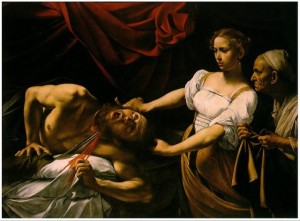CARAVAGGIO V. GENTILESCHI
The great Caravaggio (1571-1610) did many compelling paintings, but his tepid “Judith Beheading Holofernes” isn’t one of them. Holofernes is only melodramatically astonished, while Judith looks as if she’s performing some mildly distasteful task like combing out head lice, and even at that appears to be having second thoughts. Her maidservant stands by with a severe expression. Her usefulness to Carravaggio is to provide age and wrinkles to contrast with Judith’s youth and beauty.


Compare that with the version done some twenty years later by Artemisia Gentileschi (1593-1652). It obviously takes off the Caravaggio, but adds serious punch. Caravaggio presents a leisurely frieze of dramatically lit figures artfully disposed from left to right, but Gentileschi compresses the group into a tight web of crisscrossing, interlocking arms. It’s a fight: Holofernes thrashes, trying to push his attackers away; the maidservant (young and determined, like her boss) piles on; Judith has her knee on his neck as she saws away with the sword, putting her back in it. Blood spatters her, but her expression is cool–she’s focused on getting the job done. Caravaggio sets Judith apart by her brilliant white blouse and lovely face and arms in silhouette against blackness, but Gentileschi’s piece has no such decorative progressions. She uses low-key colors throughout, and whites and light skin tones only in bright, local flickers, to keep the eye bouncing around. Her subject is the intimacy of the violence between the three players.
Gentileschi had a hard life, to the hardness of which brutal men made major contributions. Judith’s story was a myth to Caravaggio, but not to Artemisia.

Oddly, at about the same time, Gentileschi painted this moment after the beheading. It’s a lovely rendering of drapery and skin, but that’s all it is. How clean the sword is, and reticent the severed head. Go figure.
Addendum, April 13: Then we get the dramatic announcement that a new Caravaggio on this subject has recently been discovered in someone’s attic. Experts disagree whether it is, in fact, by Caravaggio, but the dealer offering it professes great confidence, and values it at $136,000,000.
I must disagree with the dealer. I don’t claim to be an expert, but I have eyes. Clearly it’s after Caravaggio, but the master could never have perpetrated such a dramatically incoherent and psychologically absurd composition.
![[theguardian.com]](http://www.stanwashburn.com/wp-content/uploads/2016/03/Caravaggio-Judith-etc-theguardian.com_.jpg)
This post is a reprise from October 15, 2011